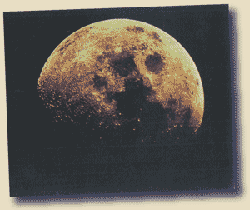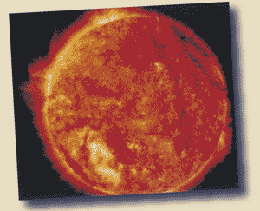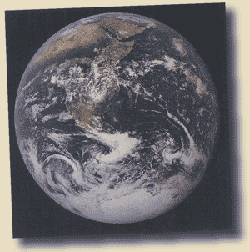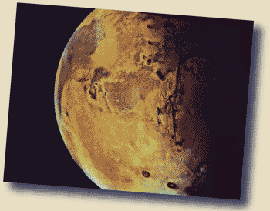|
||||||||||
|
|||||||||
| Questions/instructions: Ka
whakawhitiwhiti körero tätou mö te marama, te rä,
Papatuanuku me te aorangi o Matawhero (Tümatuaenga). |
|||||||||
| %
responses |
|||||||||
 Whakaaturia
te pikitia o te marama ki te äkonga (pikitia 1). Whakaaturia
te pikitia o te marama ki te äkonga (pikitia 1).Anei tëtahi pikitia o te marama. Show student moon (picture 1). Here is a picture of the moon. |
|||||||||
| 1.
He aha hoki te marama? He aha ngä körero e möhio ana koe mö te marama? What is the moon? Try to tell me all that you know about the moon. |
satellite
of the Earth (travels round the earth) |
2 |
|||||||
| smaller
than Earth |
4 |
||||||||
| made
of rocky materials |
12 |
||||||||
| about
400,000kms from Earth |
0 |
||||||||
| reflects
sun onto Earth (provides light at night) |
8 |
||||||||
| has
lots of craters |
8 |
||||||||
| has
no atmosphere/oxygen/ air/ozone/clouds, etc. |
4 |
||||||||
| any
other valid scientific response |
0 |
||||||||
| 2.
Whakaarohia kua tae atu koe ki te marama. He aha tëtahi ähuatanga tino rerekë ake i te noho ki Papatuanuku, ka pä ki a koe i te marama? Imagine you have arrived on the moon. What would you notice that is different from being on planet Earth? |
no
atmosphere/oxygen/air |
41 |
|||||||
| black
sky all the time |
8 |
||||||||
| you
can see the earth from there |
0 |
||||||||
| less
gravity than on Earth |
0 |
||||||||
| [no
gravity] |
[24] |
||||||||
| no
vegetation/animals/people |
33 |
||||||||
| rocky/dusty/barren
landscape |
18 |
||||||||
| no
water |
12 |
||||||||
| 3.
He aha te take e kite ana tätou i te marama? He äwhina: Mä te aha tatou e kite ai i te marama? How is it that we can see the moon with our eyes? Prompt: What makes the moon visible to us? |
light
of sun reflected from moon |
19 |
|||||||
| 4.
He aha e rerekë ai te ähua o te marama e kite ana tätou?
He äwhina: Whakamäramahia mai he aha e rerekë ai te ähua o te marama i ëtahi pö. Why do you think that the moon appears to change its shape? Prompt: Try to explain why the moon looks different at different times of the month or year. |
part
seen (as bright) depends on relative
positions of sun, moon and earth |
6 |
|||||||
| has
idea, but not well explained |
17 |
||||||||
E ai ki ngä kaipütaiao, käore te tangata pënei i a tätou e ora ki Matawhero, engari ka ora tätou ki Papatuanuku. Here is a picture of planet Earth and a picture of planet Mars. Scientists tell us that people like us cannot live on Mars but we know that we can live on planet Earth. |
|||||||||
| 5.
He aha ngä take käore te tangata e ora ki Matawhero? Körerohia
mai ngä take katoa e möhio ana koe. Why can’t people live on planet Mars? Tell me as many reasons as you can think of. |
Temperature: (very hot during day, cold at night) |
||||||||
| both
|
0 |
||||||||
| just
one |
52 |
||||||||
| atmosphere
issues |
54 |
||||||||
| lack
of water |
30 |
||||||||
| lack
of food |
12 |
||||||||
| 6.
He aha tätou te tangata e ora ai ki Papatuanuku? Körerohia mai
ngä take katoa e möhio ana koe. Why are we able to live on planet Earth? Tell me as many reasons as you can think of. |
temperature
suits our bodies |
6 |
|||||||
| air/oxygen/atmosphere
|
71 |
||||||||
| water |
54 |
||||||||
| food
sources |
43 |
||||||||
 Whakaaturia
te pikitia o te rä (Pikitia 4) ki te äkonga. Whakaaturia
te pikitia o te rä (Pikitia 4) ki te äkonga.Anei tëtahi pikitia o te rä. Show student Sun (picture 4). Here is a picture of the sun. |
|||||||||
| 7.
Ehara te rä i te aorangi. He aha hoki te rä? The sun is not a planet. What is the sun? |
star
|
52 |
|||||||
| ball
of fire/gases |
20 |
||||||||
| 8.
He aha ngä ähuatanga rerekë o te rä me Papatuanuku?
How is the sun different from planet Earth? |
much
bigger |
22 |
|||||||
| extremely
hot/ball of fire |
82 |
||||||||
| no
life or life requirements (e.g. water/oxygen) |
14 |
||||||||
| no
well defined surface (outer layers gas/plasma rather than solid/liquid) |
6 |
||||||||
Total
score: |
20–33
|
0 |
|||||||
| 16–19
|
0 |
||||||||
| 12–15
|
20 |
||||||||
| 8–11 |
28 |
||||||||
| 4–7
|
47 |
||||||||
| 0–3
|
5 |
||||||||
| Commentary: Students showed quite limited knowledge of the moon and Mars, but substantially more knowledge of the Earth and sun. |
|||||||||
| |
||

